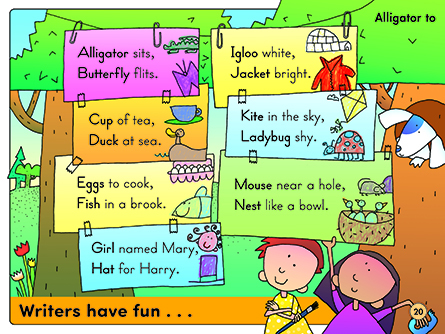Additional Activities
These activities offer options for continuing the learning in this unit. Whether your curriculum is skill-based or more open-ended, select the activities that are most appropriate for the children in your classroom. The Writing Spot is primarily a writing program, but writing can be integrated throughout your curriculum—in art, drama, reading, math, and science.
-
Do a Q and A based on “Alligator to Zipper-Dee-Do!”
Ask questions: Where do eggs come from? Where do alligators live? Are ladybugs really shy? Where can I find a turtle sunning? Encourage students to come up with more questions. As children discover answers to their questions, challenge them to make up rhymes about what they’ve learned.
Assign the letters A-Z to individual children. Over a week’s time, have the students collect and write down as many words as they can that begin with their letter of the alphabet. Provide plenty of materials in the classroom for the children to work with, especially picture dictionaries and word books. Combine the children’s lists to create an alphabet book for the writing center.
Read poetry and familiar rhymes to the children. Talk about the words that rhyme. Ask children to identify and write pairs of rhyming words. Then, as a class project, use these words to create a class poem.
-
Use pictures as ideas for rhymes.
Read picture books of poems and rhymes. Talk about how the pictures explain the words. Show children a pair of pictures (for example, a dog and a cat). As a class, write a rhyme using the names of the pictures. Ask children to illustrate the class rhyme with their own drawings.
-
Work with rhyming riddles.
Use simple rhymes as thinking games. Read rhyming riddles to children and challenge them to guess the answers.
-
Have fun with alphabet letters.
Mix repetition with variety when reinforcing letters of the alphabet. Sing songs about letters, play games with letters, hide letters for children to find. The alphabet is a child’s first introduction to the mechanics of writing. If letter recognition is fun for children, they will be more interested in learning about sounds and words.
-
Make up ABC rhymes together.
Try this as an ongoing shared-writing activity. See if the children can make up a rhyme for each letter of the alphabet. It might go something like this:
The letter A likes the middle of day.
The letter B likes to rhyme with me.
The letter C drinks a cup of tea.
Create a bulletin-board display using your children’s ABC poem.
